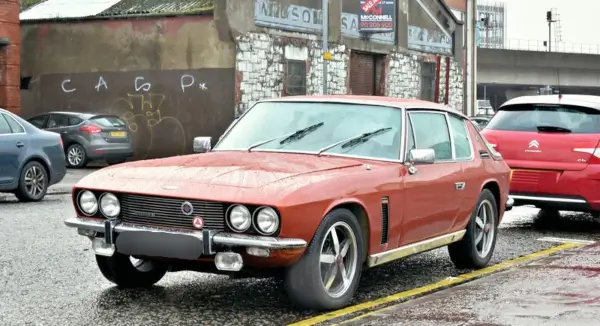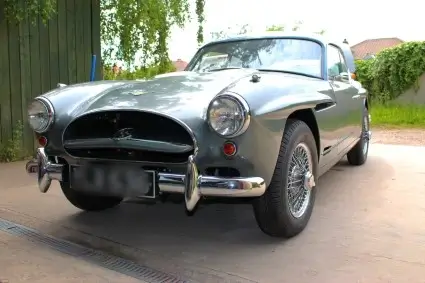Jensen Tyres
Classic Jensen Tyres
On the following pages, Longstone Classic Tyres give classic tyre fitment recommendations for Jensen cars.
If your car is not listed, don't panic! Please give us a call on:
01302 711 123
or
Email: sales@longstonetyres.co.uk
Jensen Tyre
- 1950’s Interceptor 600X16 crossply original. We recommend 185 VR 16 PIRELLI CINTURATO ™; CA67. Tyre pressure 32psi front and rear.
- 1950’s 541 crossply 550X16 was original. We recommend 5.50 R 16 Michelin X. Tyre pressure 30psi front and rear.
- 1960’s 541 S & R 640X15 Crossply. We recommend 185 VR 15 PIRELLI CINTURATO ™; CA67. Tyre pressure 30psi front and rear.
- C-V8 Original Crossply was 670X15. We recommend 185 VR 15 PIRELLI CINTURATO ™; CA67. Tyre pressure 30psi front and rear.
- Jensen Interceptor, 205/70 WR 15 PIRELLI CINTURATO ™; CN12 was one of the original tyres and we would suggest it is still perfect for these cars. We would recommend 32psi front and 36psi rear.
- 4X4 Jensen Interceptor FF had larger tyres 215/70 WR 15 PIRELLI CINTURATO ™; CN12. Tyre pressure 32psi front, 36psi rear.
- Jensen Healey did and in our mind would still fit 185/70 VR 13 PIRELLI CINTURATO ™; CN36. Tyre pressure 28psi front and rear.
- Jensen GT Estate fitted 185/70 VR 13 PIRELLI CINTURATO ™; CN36. Recommended tyre pressure; 24psi front, 28psi rear.
Jensen History
Alan and Richard Jensen were born in Birmingham, England, in the first decade of the twentieth century. They showed an early interest in automobiles and a proclivity for designing and manufacturing them. While still apprentices in the Birmingham motor business, they fashioned a racy little body on a second-hand Austin Seven chassis in 1928. Their Austin special piqued the interest of Standard Motor Company's Chief Engineer, leading to a contract to construct something comparable on a Standard chassis.

When the brothers' vision for a powerful, well-appointed open tourer was achieved in 1935, the first true Jensen automobile debuted. Powered by a Ford 3½ litre flathead V8, the "White Lady," as this endeavour was supposedly nicknamed, can be considered the beginning of real Jensen vehicle manufacturing. The number of passenger cars produced during the period was small, but the automobile industry was supported by a healthy trade in commercial bodywork for trucks, vans, and buses. Jensens produced a groundbreaking light alloy truck in 1939 that outperformed the weight-for-speed constraints of the time, allowing it to transport huge cargoes fairly inexpensively.
Jensen's automobile and truck output was reduced for the length of the war, but income from wartime contracts helped the company when peace arrived. Work on a postwar design began quickly, and the Jensen PW was presented in 1946. It was designed as a luxury saloon for the wealthy, picking up where the automobiles of the pre-war era had left off. However, with wartime constraints on the availability of materials still in effect, few were manufactured. In 1950, a more contemporary design was introduced. The "Interceptor" had a light alloy body and was powered by Austin's renowned 4-litre six-cylinder engine. Interceptors were manufactured until 1958 when a totally new kind of Jensen became the standard at Carters Green.

The 541 was first seen in prototype form in 1953 and went into production in 1955. It was powered by the Austin six, like the Interceptor, but it was groundbreaking in that the body was built of fibreglass. 541s were popular as long-distance touring automobiles until 1962 when a considerably more powerful Jensen grand tourer debuted. This vehicle, nicknamed the C-V8, used a 6-litre Chrysler engine and was the quickest road-going four-seater tested by Autocar at the time. By 1966, production had reached 500, and the decision was made to outsource the firm's next body design to Italy.
The Jensen brothers, now older and in poor health, left in disgust, as did their top body engineer, Eric Neale, who had been with them for 20 years. Later that year, at Earls Court, two new steel-bodied Jensens made their premiere. These were the Touring-designed Interceptor and the FF, a four-wheel-drive variation featuring Maxaret anti-lock braking, a global first for the little West Bromwich business. By the late 1960s, issues with the release of these cars, along with the completion of the primary underlying contract work on the Austin Healey, had created some uncertainty in Jensen's financial affairs. Jensen's holding firm, NORCROS, called in experts to work things out, one of which being Carl Duerr, an American troubleshooter.
Kjell Qvale, another American, took over the corporation in 1970. Qvale, a well-known distributor of British sports cars in the United States, purchased the company from Brandts in order to obtain the means of developing a replacement sports vehicle for the Austin Healeys that he had been selling commercially via his American distributorships. This required Duerr to resign, which he did grudgingly when his own attempt to take over Jensens failed. Qvale's crew moved in, and Jensens immediately began development on a new sports vehicle designed by Donald Healey.
In 1971, the year the FF was phased out and upgraded versions of the Interceptor were launched, prototypes of what would become the Jensen-Healey with a Lotus 16-valve engine were running. The SP, for example, featured a high-compression 440 engine with three twin-barrel carburettors, Jensens' biggest and most powerful engine arrangement yet.
The Jensen-Healey went into production in 1972, and things looked up for a while. However, the first of the oil shocks caused widespread damage in the automotive sector in 1973. Jensens suffered greatly as a result of the subsequent loss of consumer confidence. Despite an intensive defect-rectification campaign on the trouble-prone Healey, Qvale finally found himself with little choice but to pull the plug. The receivers were brought in in September 1975, the situation was examined, and limited manufacture was permitted to continue until Jensen Motors Ltd. ceased operations in May 1976.



